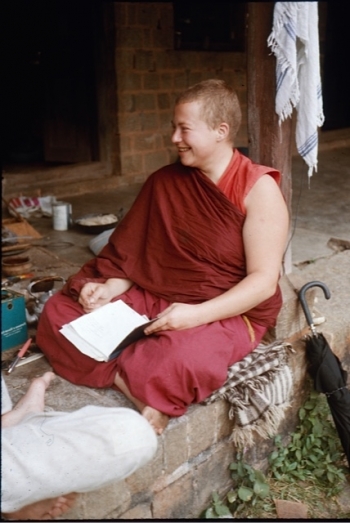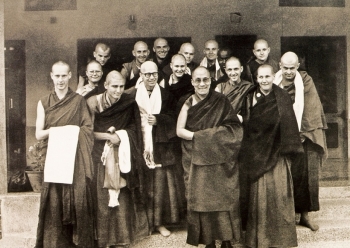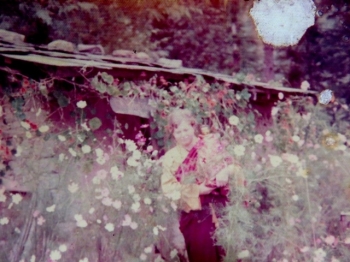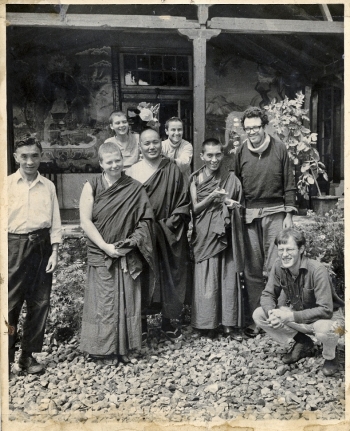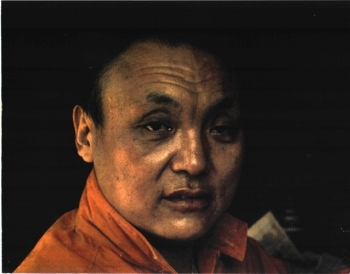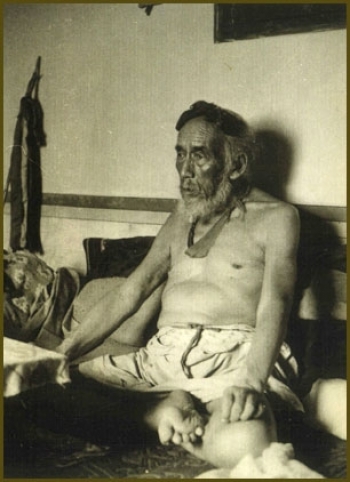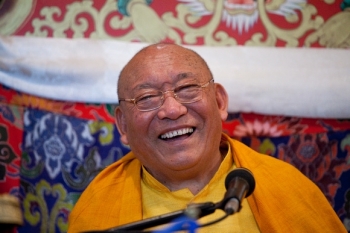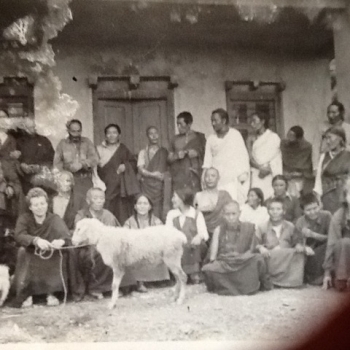Ani Zamba Chozom was one of the first Westerners to be ordained as a Buddhist nun. Born in England in 1948, a serious illness as a teenager aroused in her a strong desire to benefit others. In search of answers to her confusion about life, in the 1960s she traveled overland to India, and has since practiced in many different countries and traditions. Today she lives mainly in Brazil, where her practical teachings, rooted in the simplicity of Dzogchen, are proving an inspiration to Buddhists and non-Buddhists alike. On a recent visit to Hong Kong, Frances McDonald interviewed her about her fascinating life, which will be published here on Buddhistdoor in eight weekly parts.*
FM: After leaving Nepal, you went back to Geshe Rabten in Dharamsala, in India. Did you go back into retreat?
AZ: I started off with philosophical training, but I was really not happy, going up and down the mountain every day to study endless ideas and concepts about things. It was so dry and intellectual! I said to Geshe Rabten, “Do I really have to do this?” And he said, “No, but you’ll find it very helpful later on in your life when it comes to being able to teach, because you’ll understand different people’s views, the way that they see things in different ways. And this philosophy is just about seeing in different ways.” I said, “I don’t think I can do it.” So he said, “Okay, you don’t have to go down any more, you just stay up on the mountain with me. Stay in retreat, and I’ll give you all the teachings you need.” That was great! In fact I’d already received a lot of teachings from some of the main lamas in Dharamsala and I’d taken certain empowerments, and the commitment at that time was either that you had to do the sadhana every day for the rest of your life, or you had to go into long retreat and accumulate certain practices. So that’s what I decided to do. I did Vajrasattva, which is part of the ngöndro [preliminaries], and then I went into an 18-month solitary yidam [specific deity] retreat.
FM: So you were practicing in the Gelugpa tradition.
AZ: Yes, I did not know that were other lineages of practice at that time. During my retreat, HH the Dalai Lama requested Geshe Rabten to go to Switzerland to head Rikon, the Swiss center, which was a difficult time for me as I honestly didn’t have a heart connection with any other teacher in Dharamsala, and it became clear to me that I had no karmic connection with Tsongkhapa [the founder of the Gelugpa lineage; 1357–1419]. So I thought maybe I wasn’t in the right tradition. I’m not saying anything against Tsongkhapa—it was just that my connection didn’t give me the inspiration to progress along that path. Whereas, when I went back to the UK I’d met Tenzin Palmo—we met on a bus. And I looked at her, and she had Tibetan robes on, and she looked at me and I was also wearing Tibetan robes, and I said, “Where are you going?” And she said, “I’m going to a Sufi meeting. Where are you going?” And I said, “I’m also going to a Sufi meeting”! And then we got talking, and we met again, and she kept talking about her lama Khamtrul Rinpoche and the Togdens, in Tashi Jong. She talked about the wonderful yogis there and how she was inspired. So I thought, “I’m going to Tashi Jong! This sounds like what I’ve been looking for.”
FM: And you went?
AZ: Yes. After the solitary retreat, in around 1972–73, I started to go to Tashi Jong regularly and to take teachings from Khamtrul Rinpoche, Dugu Choegyal Rinpoche, Dorzong Rinpoche, and the teacher of the Togdens, Togden Choelek Rinpoche. More and more, I felt embraced by that tradition, which was the Drukpa Kagyu tradition. I really wanted to live there with Khamtrul Rinpoche, but there was nowhere to live—it was a refugee community, a handicrafts community. It wasn’t very supportive for meditation practice, and the Togdens lived away from the gompa. Anyway I went to Khamtrul Rinpoche and said, “Please can I come and live here,” but he said, “It’s probably better you stay in Dharamsala.” I was very disappointed. And then again I asked him, so he did a mo[divination] and he said, “It’s not good and it’s not bad. If you really want to come, you can come, but I don’t know where you’re going to live.” And that was the situation. I went there and it was hot, dry, dusty, and noisy because of all the activity. There was nowhere to really go and sit quietly and get on with practice. I had a room in one of the Tibetans’ houses, which was tiny. So, though I was happy to be there with Rinpoche, I really didn’t feel it was the right place to be able to go into retreat.
AZ: I’d had quite a few teachings by then, and I’d heard about the community in Tso Pema [Rewalsar], so I went there. There were many monks, nuns, yogis, yoginis, ngakpas [Tantric lay practitioners], and one other Westerner. And I went to Lama Wangdor, who is a holder of the Drukpa Kagyu and Nyingma lineages—they are very close. When I arrived, he was sitting in his cave in a gomtri [meditation box]. By that time he’d already been there for about 16 years and hadn’t lain down to sleep at all—an amazing practitioner, what an inspiration! And I said, “I’d like to come and live here.” And he said, “I don’t know. All the caves are full at the moment, but we’ll go and look around.” Off we went and walked around, and we came across a rock at whose base was a tiny triangle. I remembered the story of Milarepa’s horn,** and I jokingly said to Lama Wangdor, “I’ll live there.” He looked at me and laughed, and said, “Maybe.” And then the following day he got some Indian workers from the village nearby and some of the monks, and we all went there and started digging under that little triangle. As we dug deeper, we could move inside, and it became the largest cave in Tso Pema. It was also the wettest cave, and I almost died the first week I was there, I was so ill. But I persevered, stubborn as I am, and I stayed there and did my practice.
FM: You took teachings from Lama Wangdor?
AZ: Yes, I could go at any time to get whatever teachings I wanted from Lama Wangdor, whose main teaching at that time was Garab Dorje’s “The Three Statements that Strike the Essential Points.” That was wonderful. And the great tsa lung [channels and winds] master Kunzang Dorje Rinpoche was living almost next door to me. I stayed there in retreat until I heard that the head of the Nyingma lineage, the great Dzogchen master HH Dudjom Rinpoche, was going to give the Dudjom Tersar empowerments in Nepal. I knew that I really wanted to attend these empowerments and that Chagdud Rinpoche, whom I had met whilst I was living in Tashi Jong, would want to attend them too. At that time Chagdud Rinpoche was my friend, not my teacher as such—we used to hang out together in a very informal way at his place in Bir. He was very poor in those days, so I managed with a few friends to raise the money to pay for his ticket to Nepal.
